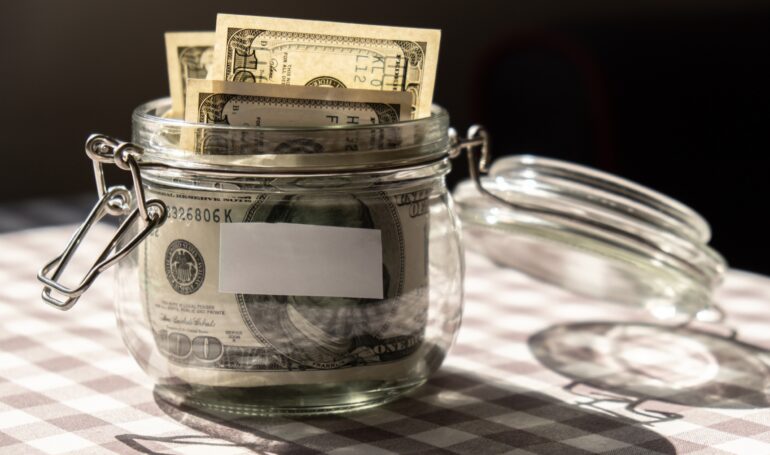Takeaways
- Slush funds help cover unforeseen expenses and provide financial flexibility.
- Slush funds should cover at least three to six months of living expenses.
- Slush funds are best stored in a separate savings account from your emergency fund.
- Slush funds allow you to search for new career options without changing your lifestyle.
- Slush funds are best stored in a high-yield savings account to help your funds grow.
Some of the links in this article are from advertising partners of Smart Money, which does not influence our evaluations or recommendations. We work to provide you with accurate and reliable information. Our opinions are our own.
Savings goals are at the top of everyone’s financial “to-do” list. How big those savings goals are and where they take you can change your trajectory. The higher your cash savings, the healthier your finances. Most personal financial experts argue to save an emergency fund plus a slush fund to gain financial security.
Knowing where to start on your savings journey can be a game-changer. The first step of any savings journey should begin with saving an emergency fund. This emergency fund is an account between $1,000 and $3,000 that covers unforeseen expenses. Once your emergency fund is in place, moving up the ladder of financial prosperity starts with saving a slush fund.
Get Smart With Your Money
Fresh weekly articles delivered straight to your inbox.
Enter your name and email for free tips and tricks.

What is a Slush Fund?
A slush fund is a pool of capital set aside that could pay for your monthly living expenses for several months. A good rule of thumb is to have a slush fund full of cash or short-term investments that could pay for at least three to six months of living expenses.
Smart Money -> What is a Certificate of Deposit?
Your slush fund should be at least three to six months of living expenses because it typically takes around 90 days to find new employment. A slush fund provides a fantastic hedge against unforeseen unemployment or voluntary unemployment. If you get sick of your job and want to leave and find a new job or start your own business, a slush fund can help you accomplish this without changing your lifestyle.
It is important to note that your slush fund does not include your emergency fund. When calculating the total amount you need to save for your slush fund, only use the amount above and beyond your emergency fund balance.
Smart Tip:
Stashing your slush fund savings in a high-yield savings account will help you reach your savings goal faster and provide easy access to your funds.
How Big Should My Slush Fund Be?
Monthly expenses can vary tremendously among households. Instead of using dollar-based savings targets, financial experts recommend having a slush fund to cover at least 3-6 months of living expenses. This advice considers the variance in monthly living expenses based on geography, lifestyle, and life stage. The higher your monthly living expenses, the higher your total absolute savings will need to be.
Smart Money -> 12 Ideas for Making Money in Less Than One Hour
Another reason financial experts advocate for at least 3-6 months of living expenses is that it generally takes 90 days to find new employment, and your slush fund hedges against financial calamity if you leave your job, decide to take a mini-retirement, or find a new job.
Smart Money -> 10 Steps to Get the Raise You Deserve
The general rule of thumb is that the larger your slush fund, the greater your short-term financial health. Let’s look at how to tactically create a slush fund.
How to build a slush fund in 4 easy steps:

Member FDIC
Axos Bank® Rewards Checking
Smart Money Rating: 5/5
APY: 3.30% with No Minimum Balance
Bonus Offer: Up to $300 Bonus (Terms Apply)
1. Calculate Your Monthly Living Expenses
There are two schools of thought when calculating your monthly living expenses for your slush fund.
The first school of thought says to consider all the monthly expenses to support your current lifestyle. That means all costs you incur when living your life to the fullest. These expenses include nights out with friends, eating out, and travel expenses.
Smart Money -> What is 50/30/20 Budgeting?
The second school of thought advocates only including your minimum monthly spend. Using your minimum monthly spend is a bare-bones approach that aims to maintain your fixed costs – rent, mortgage, insurance – and only spend sparingly on variable costs, like transportation, groceries, or fun.
Smart Money -> What is Zero-Based Budgeting?
Choose a strategy that fits your personality and check your budget with how much you can spend each month. Your current budget should serve as a great cheat sheet.
Expenses to Consider:
- Rent or Mortgage
- Groceries
- Transportation
- Travel
- Internet
- Cell Phone Bill
- Cable Bill
Smart Money -> 14 Wacky Ways to Cut Monthly Expenses Quickly
2. Choose Your Multiplier
Once you have calculated your monthly living expenses, it is time to determine how large you want your slush fund to be. Aiming for a balance of three months will meet the minimum recommended slush fund amount. However, if you want to be on the higher end of the spectrum, finance professionals argue for saving at least six months of living expenses or more.
Smart Money -> 7 Types of Certificates of Deposits
Saving more than six months of living expenses in cash and short-term investments (like CDs) can provide maximum flexibility. Here’s Smart Money’s chart of financial health categories according to your slush fund:
| Slush Fund | Financial Health Status |
|---|---|
| 0-1 Month | Starting Out |
| 1-3 Months | Slight Padding |
| 3-6 Months | Recommended Slush Fund |
| 6-12 Months | Overachiever with Options |
| + 1 year | Full Optionality |
Smart Tip:
If you save over six months of living expenses, consider learning how to invest excess cash to earn more substantial returns on your cash.
For example, if you spend $5,000 monthly and want to maximize your slush fund with a six multiplier, you will need to save $30,000. Your slush fund should be in a separate savings account from your emergency fund. As a result, you should have a $3,000 emergency fund plus a slush fund of $30,000 for a total savings of $33,000.
When contemplating how much to save in your slush fund, it is vital to consider the savings process one month at a time. Don’t become overwhelmed with the total dollar amount needed to hit your goal. Like paying off debt, it’s about reverse engineering how you can meet your goals. The important part is to start the process.
3. Saving Your Money
Where should you put your slush fund? It is critical to separate your slush fund from your other accounts. As a standalone account, you invest these savings in a high-yield savings account or short-term investment (like a certificate of deposit).
Smart Tip:
Automating your savings can help significantly with decision fatigue about how much and when to save. Get your savings on the right track, then set it and forget it.
The slush fund democratizes the definition of short-term financial health because it uses a multiplier of financial spending. No matter who you are, there are only two ways to increase your financial situation: boost your income or decrease your expenses. The slush fund utilizes both variables. The more you earn and the less you spend, the faster you can achieve your slush fund goals. By saving your slush fund, you will be one more step up the ladder of financial success.
Smart Money -> How to Achieve Financial Independence
4. Monitor Your Slush Fund
As you start saving for your slush fund, it is critical to measure your performance. Budgeting to save for your slush fund only takes a few minutes. Fund a budgeting strategy that fits with your lifestyle and personality. Saving only $100 a month can quickly add up over time.
Stashing your slush fund in a high-yield savings account will help grow your funds. However, if your income or monthly living expenses increase, it could be a great time to boost your slush fund savings. Remember that the slush fund is always based on your spending patterns, so when you increase your spending, you also need to add to your slush fund balance.
At some point, it makes sense to start investing your cash in stocks, bonds, or other investments to increase your returns over what you are earning on a high-yield savings account. Periodically review your slush fund balance and earnings.
Smart Money -> What is a Stock? How to Buy Stocks and More.
Smart Summary
Saving a slush fund is one of the smartest moves you can make. Once you have established your emergency fund to hedge against immediate unforeseen expenses, a slush fund can provide you with the peace of mind that you are financially secure if you want to look for a new job, take some time off, or start a new business. Consult your budget and long-term financial plans and start saving for your slush fund today.








